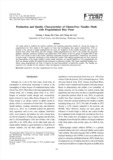

PARTNER
검증된 파트너 제휴사 자료
Production and Quality Characteristics of Gluten-Free Noodles Made with Pregelatinized Rice Flour
방대한 850만건의 자료 중 주제별로 만들수 있는 최적의 산출물을 해피 캠퍼스에서 체험 하세요 전문가의 지식과 인사이트를 활용하여 쉽고 폭넓게 이해하고 적용할수 있는 기회를 놓치지 마세요
7 페이지
최초등록일 2023.09.25
최종저작일
2023.08

-
 * 본 문서는 배포용으로 복사 및 편집이 불가합니다.
* 본 문서는 배포용으로 복사 및 편집이 불가합니다.
미리보기
서지정보
· 발행기관 : 한국산업식품공학회
· 수록지 정보 : 산업식품공학 / 27권 / 3호
· 저자명 : Gyeong A Jeong, Rin Chae, Chang Joo Lee
목차
Abstract
Introduction
Materials and Methods
Materials
Preparation of noodles with rice flour
Color and appearance of uncooked noodles
Textural properties of noodles
Tensile properties of noodles
Cooking characteristics of noodles
Elution of cooked noodles
Results and Discussion
Color and appearance of uncooked noodles
Textural properties of noodles
Tensile properties of noodles
Elution and cooking characteristics of noodles
Conclusion
References
Author Information영어초록
This study aimed to establish the optimal conditions for producing gluten-free noodles by varying the amount of pregelatinized rice flour added to the regular rice flour and investigating their quality characteristics. With an increase in the amount of added pregelatinized rice flour, the brightness of the noodles decreased, and the color became more yellow both before and after cooking. Adding pregelatinized rice flour to the noodles also increased hardness, elasticity, chewiness, stickiness, and adhesiveness. The textures of the two groups of samples (PR-10 and PR-15) were similar to that of the control, indicating comparable structural characteristics. Furthermore, the absence of gluten made it inherently challenging to form gluten-free noodles. Still, adding pregelatinized rice flour improved the processability of the dough, leading to better noodle formation. An optimal addition of 15% pregelatinized rice flour was deemed suitable for optimal noodle formation in gluten-free noodles. This study established blending conditions using pregelatinized rice flour to improve the poor processability of gluten-free noodles. The findings are expected to be valuable for the industry’s future development of gluten-free processed food.참고자료
· 없음태그
-
자료후기
-
자주묻는질문의 답변을 확인해 주세요

꼭 알아주세요
-
본 학술논문은 (주)코리아스칼라와 각 학회간에 저작권계약이 체결된 것으로 AgentSoft가 제공 하고 있습니다.
본 저작물을 불법적으로 이용시는 법적인 제재가 가해질 수 있습니다. -
해피캠퍼스는 구매자와 판매자 모두가 만족하는 서비스가 되도록 노력하고 있으며, 아래의 4가지 자료환불 조건을 꼭 확인해주시기 바랍니다.
파일오류 중복자료 저작권 없음 설명과 실제 내용 불일치 파일의 다운로드가 제대로 되지 않거나 파일형식에 맞는 프로그램으로 정상 작동하지 않는 경우 다른 자료와 70% 이상 내용이 일치하는 경우 (중복임을 확인할 수 있는 근거 필요함) 인터넷의 다른 사이트, 연구기관, 학교, 서적 등의 자료를 도용한 경우 자료의 설명과 실제 자료의 내용이 일치하지 않는 경우
문서 초안을 생성해주는 EasyAI

